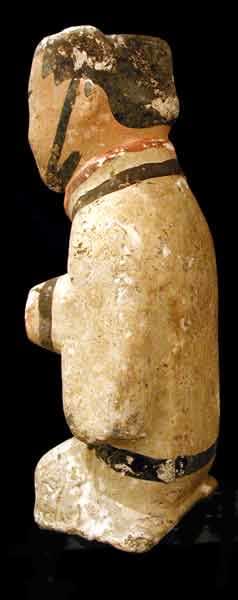Pair of Western Han Painted Terracotta Officials, 206 BCE - 9 CE
Terracotta
10.5
PF.5616
Further images
The overextension of the labor force during the Qin Dynasty would result in a popular uprising against the empire. In 206 B.C., Liu Bang, a Qin official, led an army...
The overextension of the labor force during the Qin Dynasty would result in a popular uprising against the empire. In 206 B.C., Liu Bang, a Qin official, led an army composed of peasants and some lower nobility to victory and established his own Dynasty in place, the Han. However, unlike the Qin, the Han would unify China and rule virtually uncontested for over four hundred years. It is during this time that much of what is now considered to be Chinese culture was first actualized. The bureaucracy started under the Qin was now firmly established. The vast lands of China were now under the firm grip of a central authority. Confucianism became the state ideology although the worship of Taoist deity remained widespread, both among the peasants and the aristocracy. Ancient histories and texts were analyzed and rewritten to be more objective while new legendary myths and cultural epics were transcribed.
The Han era can also be characterized as one of the greatest artistic outpourings in Chinese history, easily on par with the glories of their Western contemporaries, Greece and Rome. Wealth pouring into China from trade along the Silk Road initiated a period of unprecedented luxury. Stunning bronze vessels were created, decorated with elegant inlaid gold and silver motifs. Jade carvings reached a new level of technical brilliance. But perhaps the artistic revival of the Han Dynasty is nowhere better represented than in their sculptures and vessels that were interred with deceased nobles. Called mingqi, literally meaning “spirit articles,” these works depicted a vast array of subject, from warriors and horses to ovens and livestock, which were buried alongside the dead for use in the next world, reflecting the Chinese belief that the afterlife was an extension of our earthy existence. Thus, quite logically, the things we require to sustain and nurture our bodies in this life would be just as necessary in our next life.
Wearing short, snug caps, the attendants stand with their arms forward and body slightly tilted, perhaps as a gesture of humility. The face of one man is painted in a reddish, fleshy tone while the other is painted white. The cheeks, nose and high brow are delicately impressed as the remaining features are painted on such as the moustaches, eyes, eyebrows, and red lips. Both attendants wear crossover white robes with contrasting black borders at the collar and the sleeves of the red-faced figure. Layers of red and white undergarments are shown at the neck and wrist. Both men are missing their hands; holes in the arms indicate that hands or objects were once attached. By the Han Dynasty, the custom of burying objects with the dead had become an established practice among the Chinese people. Representations of the imperial elite were often cast in stone, while clay models such as these served the needs of the lower stratum of the ruling classes. The clay figures stood at ground level, depicting scenes and images of ordinary life from a Confucian moralistic point of view. Based on the belief that the spirit and vitality of the subjects were embodied in the figurines, the burial objects served an important role in the ancestral belief system of ancient Chinese society.
The Han era can also be characterized as one of the greatest artistic outpourings in Chinese history, easily on par with the glories of their Western contemporaries, Greece and Rome. Wealth pouring into China from trade along the Silk Road initiated a period of unprecedented luxury. Stunning bronze vessels were created, decorated with elegant inlaid gold and silver motifs. Jade carvings reached a new level of technical brilliance. But perhaps the artistic revival of the Han Dynasty is nowhere better represented than in their sculptures and vessels that were interred with deceased nobles. Called mingqi, literally meaning “spirit articles,” these works depicted a vast array of subject, from warriors and horses to ovens and livestock, which were buried alongside the dead for use in the next world, reflecting the Chinese belief that the afterlife was an extension of our earthy existence. Thus, quite logically, the things we require to sustain and nurture our bodies in this life would be just as necessary in our next life.
Wearing short, snug caps, the attendants stand with their arms forward and body slightly tilted, perhaps as a gesture of humility. The face of one man is painted in a reddish, fleshy tone while the other is painted white. The cheeks, nose and high brow are delicately impressed as the remaining features are painted on such as the moustaches, eyes, eyebrows, and red lips. Both attendants wear crossover white robes with contrasting black borders at the collar and the sleeves of the red-faced figure. Layers of red and white undergarments are shown at the neck and wrist. Both men are missing their hands; holes in the arms indicate that hands or objects were once attached. By the Han Dynasty, the custom of burying objects with the dead had become an established practice among the Chinese people. Representations of the imperial elite were often cast in stone, while clay models such as these served the needs of the lower stratum of the ruling classes. The clay figures stood at ground level, depicting scenes and images of ordinary life from a Confucian moralistic point of view. Based on the belief that the spirit and vitality of the subjects were embodied in the figurines, the burial objects served an important role in the ancestral belief system of ancient Chinese society.
Literature
V30









